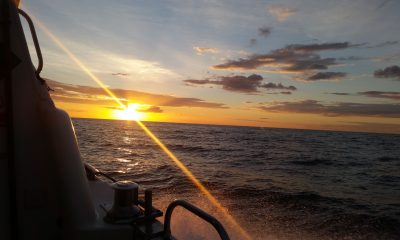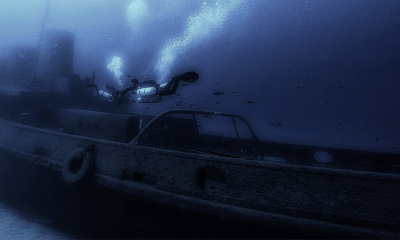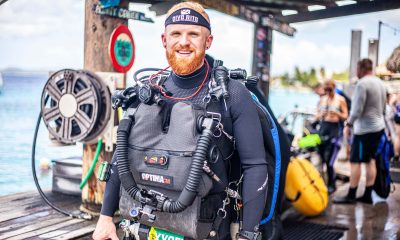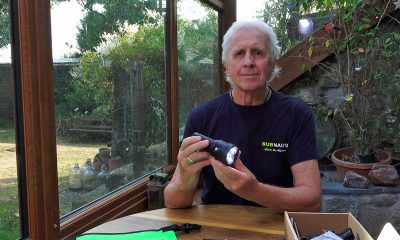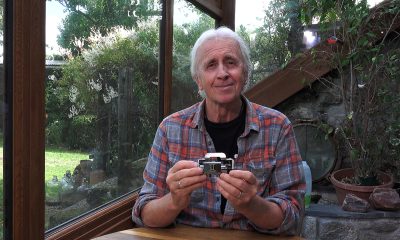News
Rebreather 101 with Paul Toomer
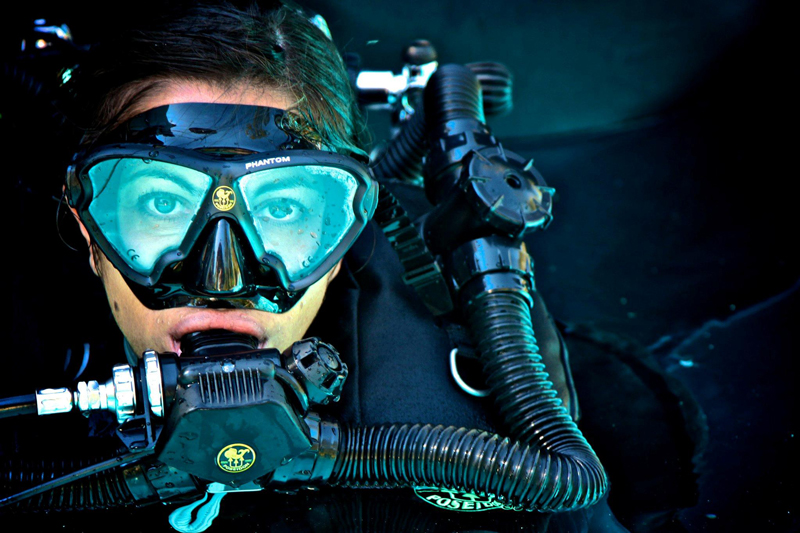
How many of you have heard of Jacques Cousteau? All of you, right?
If you don’t know who he is, you need to be on the ‘Horse and Hounds’ or ‘Amateur Rambling in the Cotswolds’ website rather than Scubaverse. He invented SCUBA didn’t he? Didn’t he also write a book called the silent world?
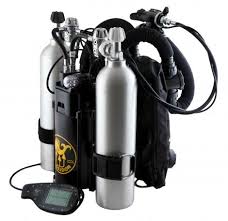 Now, we all know he didn’t invent SCUBA; that was actually some geezer whose name we can’t remember and Mr C just stole all the glory, right?
Now, we all know he didn’t invent SCUBA; that was actually some geezer whose name we can’t remember and Mr C just stole all the glory, right?
Wrong! Well… partially wrong. Mr C stole the open circuit glory but not SCUBA. SCUBA is self contained underwater breathing apparatus and it was invented a long, long time ago. And it was a Closed Circuit Rebreather (CCR). That is why his world was SILENT. Open circuit is hardly bloody silent. If you don’t believe me, take a try dive on a rebreather and listen for when the hordes of wildebeest come charging past you blowing those confounded bubbles.
What is a Rebreather?
A rebreather is a closed breathing circuit (loop) enabling gas to be recycled, therefore giving the user an extended use of the limited gas that he/she carries. There are two primary problems that have to be overcome to make the rebreather work though. The first is the fact that we metabolise oxygen, and if we breathe too low an amount of oxygen it can cause unconsciousness, which could of course lead to an ultimately death. A by-product of oxygen metabolism is the creation of carbon dioxide, and this insidious gas can also lead to unfortunate circumstances, especially underwater (as I’m sure you can imagine).
The loop and how it works
When a diver exhales, his breath is forced through a non-return valve which forces the exhaled air through a carbon dioxide removal system known as a scrubber (I love that word). The scrubber is made up of a chemical called Sofnalime, which is primarily calcium hydroxide. The exhaled breath is scrubbed clean of carbon dioxide and the breath is now pushed through an area where oxygen analysers analyse how much oxygen is left in that cleaned breath. The analysers talk to a computer (the unit holds a constant PO2 or oxygen partial pressure) which then tells a solenoid to open and add oxygen to the loop if required. This can also be done manually of course in the event of any problems.
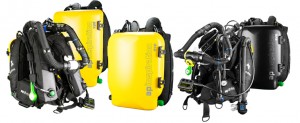 There are also counterlungs on the unit, which allow the diver to breathe gas around the loop. Without the counterlung the diver would be unable to breathe. It’s similar to trying to breath out of a glass bottle; it’s impossible. However, breathing out of a plastic bag is possible, although very unsafe. As the diver descends in the water hydrostatic pressure acts on the counterlung and compresses the gas within it. To enable the diver to breathe, diluent gas (a gas containing one or more inert gasses, normally air or trimix) is manually or automatically added to the loop.
There are also counterlungs on the unit, which allow the diver to breathe gas around the loop. Without the counterlung the diver would be unable to breathe. It’s similar to trying to breath out of a glass bottle; it’s impossible. However, breathing out of a plastic bag is possible, although very unsafe. As the diver descends in the water hydrostatic pressure acts on the counterlung and compresses the gas within it. To enable the diver to breathe, diluent gas (a gas containing one or more inert gasses, normally air or trimix) is manually or automatically added to the loop.
Finally, due to the fact that the CCR holds a constant PO2, compared to open circuit where it’s optimum PO2 is only achieved at the Maximum Operating Depth, rebreathers will penalise the diver less in terms of decompression obligation. Another huge plus.
Gas, Gas, Gas!
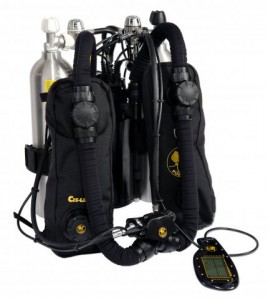 Rebreathers work on metabolic rate and not surface air consumption rate. This means that if a diver uses 20 litres of air a minute but only metabolises 1 litre of oxygen, the rebreather is massively more effective at conserving gas. An example of this based on the above gas usage rates would be: An open circuit diver is at 30 metres on the Thistlegorm, for example, and is there for 30 minutes. He uses 20 litres/min x4 ata (30 metres) x30 minutes = 2400 litres of gas, or a full 12 litre cylinder pumped to 200 bar. If a CCR diver was at the same depth and for the same time he would use only 30 litres of oxygen. Therefore, if the CCR diver had a 2 litre cylinder filled to 200 bar, he would have 400 litres available. Based on a 1 litre metabolic rate that diver could stay on the Thistlegorm for 400 minutes or 6.66 hours.
Rebreathers work on metabolic rate and not surface air consumption rate. This means that if a diver uses 20 litres of air a minute but only metabolises 1 litre of oxygen, the rebreather is massively more effective at conserving gas. An example of this based on the above gas usage rates would be: An open circuit diver is at 30 metres on the Thistlegorm, for example, and is there for 30 minutes. He uses 20 litres/min x4 ata (30 metres) x30 minutes = 2400 litres of gas, or a full 12 litre cylinder pumped to 200 bar. If a CCR diver was at the same depth and for the same time he would use only 30 litres of oxygen. Therefore, if the CCR diver had a 2 litre cylinder filled to 200 bar, he would have 400 litres available. Based on a 1 litre metabolic rate that diver could stay on the Thistlegorm for 400 minutes or 6.66 hours.
6.66 hours compared to 30 minutes? A gigantic difference I am sure you’ll agree. This is the primary reason that deep technical divers prefer CCR. It’s all in the gas.
Aquatic Life
I took a CCR to the Maldives on a liveaboard a few years ago. I never went past 40 metres for the two weeks I was there and apart from the fact that I never had any decompression schedule, I was swamped by the aquatic life. I was chased by barracuda, nibbled by moray eels, had a 2 metre stingray push me down the reef as if I was not there. Mantas thought I was some kind of weird yellow box fish and finally, the sharks…..oh my God, it was unbelievable! I had white tips on a night dive try and beat me up, chewing my fins and rubbing themselves on me as they went passed, banging into me to see what I was….just incredible. It was one of the best dives of my entire life. This dive alone was enough reason to spend all that money on my unit.
Here is a little history for you:
- 17th century – the first rebreather was conceived by Giovanni Borelli
- 1878 – the first practical system produced by Henry Fleuss, who after diving his fully working unit swore he would never dive in the damnable thing ever again. He absolutely shit himself while doing some work in a flooded tunnel.
- 1881 – the first CO2 absorbent used by Khotinsky and Lake
- Prior to WWI – Dräger started produced rebreather systems. Mainly used for blowing the crap out of poor old Allies.
- WWII – Italian & British Navies used Oxygen & Nitrox systems. The Italian units were mainly used for long swims away from enemy lines back to Italy. The British units were primarily used for blowing the crap out of the Axis countries.
- 1990s – manufacturers launch many units including: Sentinel, Inspiration, Evolution, Megaladon, Ouroboros, Kiss, Optima, rEvo, Poseidon Mk 6, etc.
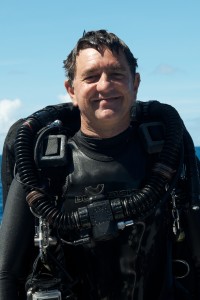 All that is left to do now is pick your unit, get some top end training and go and play. I assure you this is the future.
All that is left to do now is pick your unit, get some top end training and go and play. I assure you this is the future.
Next time we will look at some of the CCRs available, their features, recreational and technical CCR, and of course training options.
Please note that this article covers the basics of CCR. I really hope it gives you a little understanding of rebreathers, as I believe they are the way we will all dive in the future.
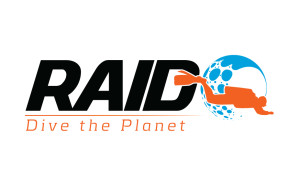 Paul is the Director of Training at RAID. To find out more about the courses that RAID offers, visit www.diveraid.com.
Paul is the Director of Training at RAID. To find out more about the courses that RAID offers, visit www.diveraid.com.
Blogs
Northern Red Sea Reefs and Wrecks Trip Report, Part 2: Wall to Wall Wrecks

Jake Davies boards Ghazala Explorer for an unforgettable Red Sea diving experience…
The second day’s diving was a day full of wreck diving at Abu Nuhas, which included the Chrisoula K, Carnatic, and Ghiannis D. The first dive of the day was onto the Chrisoula K, also known as the wreck of tiles. The 98m vessel remains largely intact where she was loaded with tiles which can be seen throughout the hold. The stern sits at 26m and the bow just below the surface. One of the highlights of the wreck is heading inside and seeing the workroom where the machinery used for cutting the tiles are perfectly intact. The bow provided some relaxing scenery as the bright sunlight highlighted the colours of the soft coral reef and the many reef fish.

Following breakfast, we then headed to the next wreck, which was the Carnatic. The Carnatic is an 89.9m sail steamer vessel that was built in Britain back in 1862. She ran aground on the reef back in 1869 and remains at 27m. At the time, she was carrying a range of items, including 40,000 sterling in gold. An impressive wreck where much of the superstructure remains, and the two large masts lay on the seafloor. The wooden ribs of the hull provide structures for lots of soft corals, and into the stern section, the light beams through, bouncing off the large shoals of glass fish that can be found using the structure as shelter from the larger predators that are found outside of the wreck.

The final wreck at Abu Nuhas was the Ghiannis D, originally called ‘Shoyo Maru,’ which was 99.5m long and built in Japan back in 1969 before becoming a Greek-registered cargo ship in 1980. The ship then ran aground on the reef on April 19th, 1983, and now sits at the bottom at a depth of 27m. Heading down the line, the stern of the ship remains in good condition compared to the rest of the hull. The highlight of the wreck, though, is heading into the stern section and down the flights of stairs to enter the engine room, which remains in good condition and is definitely worth exploring. After exploring the interior section of the ship, we then headed over to see the rest of the superstructure, where it’s particularly interesting to see the large table corals that have grown at the bow relatively quickly considering the date the ship sank. After surfacing and enjoying some afternoon snacks, we made sure everything was strapped down and secured as we would be heading north and crossing the Gulf of Suez, where the winds were still creating plenty of chop.

The next morning, it was a short hop to Ras Mohammed Nature Reserve for the next couple of days of diving. The 6am wake-up call came along with the briefing for the first site we would be diving, which was Shark & Yolanda. The low current conditions allowed us to start the dive at Anemone City, where we would drift along the steep, coral-filled wall. These dives involved drifts, as mooring in Ras Mohammed wasn’t allowed to protect the reefs. As a dive site, Shark & Yolanda is well-known and historically had a lot of sharks, but unfortunately not so many in recent years, especially not so early in the season. However, there was always a chance when looking out into the blue.

The gentle drift took us along the steep walls of the site, with plenty of anemone fish to be seen and a huge variety of corals. It wasn’t long into the dive before we were accompanied by a hawksbill turtle, who drifted with us between the two atolls before parting ways. Between the two reefs, the shallow patch with parts of coral heads surrounded by sand provided the chance to see a few blue-spotted stingrays that were mainly resting underneath the corals and are always a pleasure to see. With this being the morning dive, the early sunlight lit up the walls, providing tranquil moments. Looking out into the blue, there was very little to be seen, but a small shoal of batfish shimmering underneath the sunlight was a moment to capture as we watched them swim by as they watched us.

Towards the end of the dive, we stopped at the wreck of the Jolanda where the seafloor was scattered with toilets from the containers it was carrying. This provided a unique site to make a safety stop, which was also accompanied by a large barracuda slowly swimming by, along with a hawksbill turtle calmly swimming over the reef as the sun rays danced in the distance.
For the next dive, we headed north to the Strait of Tiran to explore the reefs situated between Tiran Island and Sharm El Sheik, which were named after the British divers who had found them. We started on Jackson before heading to Gordons Reef, where we also did the night dive. All the atolls at these sites provided stunning, bustling coral reefs close to the surface and steep walls to swim along, which always provided the opportunity to keep an eye out for some of the larger species that can be seen in the blue. Midwater around Jackson Reef was filled with red-toothed triggerfish and shoals of banner fish, which at times were so dense that you couldn’t see into the blue. Moments went by peacefully as we enjoyed the slow drift above the reef, watching these shoals swim around under the mid-afternoon sun.

The night dive at Gordon’s Reef was mainly among the stacks of corals surrounded by sand, which was great to explore under the darkness. After some time circling the corals, we came across what we were really hoping to find, and that was an octopus hunting on the reef. We spent the majority of the dive just watching it crawl among the reef, blending into its changing surroundings through changes in colour and skin texture. It’s always so fascinating and captivating to watch these incredibly intelligent animals, in awe of their ability to carry out these physical changes to perfectly blend into the reef. Before we knew it, it was time to head back to the boat to enjoy a well-deserved tasty dinner prepared by the talented chefs onboard.
Check in for the 3rd and final part of this series from Jake tomorrow!
To find out more about the Northern Red Sea reef and wrecks itineraries aboard Ghazala Explorer, or to book, contact Scuba Travel now:
Email: dive@scubatravel.com
Tel: +44 (0)1483 411590
Photos: Jake Davies / Avalon.Red
Marine Life & Conservation
Double Bubble for Basking Sharks

 The Shark Trust is excited to announce that, for two more days only, all donations, large or small, will be doubled in the Big Give Green Match Fund!
The Shark Trust is excited to announce that, for two more days only, all donations, large or small, will be doubled in the Big Give Green Match Fund!
Donate to Basking in Nature: Sighting Giants
The Shark Trust is hoping to raise £10k which will be doubled to £20k. This will go towards Basking in Nature: Sighting Giants. And they need YOUR help to reach they’re goal.
The Shark Trust’s citizen science project is to monitor and assess basking sharks through sightings; encouraging data collection, community engagement, and promoting nature accessibility. This initiative aims to enhance health and wellbeing by fostering a deeper connection with British Sharks.
Campaign Aims
- Increase citizen science reporting of Basking Sharks and other shark sightings to help inform shark and ray conservation.
- Provide educational talks about the diverse range of sharks and rays in British waters and accessible identification guides!
- Create engaging and fun information panels on how to ID the amazing sharks and rays we have on our doorstep! These can be used on coastal paths around the Southwest. With activities and information on how you can make a difference for sharks and rays!
- Promote mental wellbeing through increasing time in nature and discovering the wonders beneath the waves!
Donate, and double your impact. Click Here
-

 News3 months ago
News3 months agoHone your underwater photography skills with Alphamarine Photography at Red Sea Diving Safari in March
-

 News3 months ago
News3 months agoCapturing Critters in Lembeh Underwater Photography Workshop 2024: Event Roundup
-

 Marine Life & Conservation Blogs2 months ago
Marine Life & Conservation Blogs2 months agoCreature Feature: Swell Sharks
-

 Blogs2 months ago
Blogs2 months agoMurex Resorts: Passport to Paradise!
-

 Blogs2 months ago
Blogs2 months agoDiver Discovering Whale Skeletons Beneath Ice Judged World’s Best Underwater Photograph
-

 Gear Reviews2 months ago
Gear Reviews2 months agoGear Review: Oceanic+ Dive Housing for iPhone
-

 Marine Life & Conservation2 months ago
Marine Life & Conservation2 months agoSave the Manatee Club launches brand new webcams at Silver Springs State Park, Florida
-

 News3 months ago
News3 months agoWorld’s Best Underwater Photographers Unveil Breathtaking Images at World Shootout 2023



